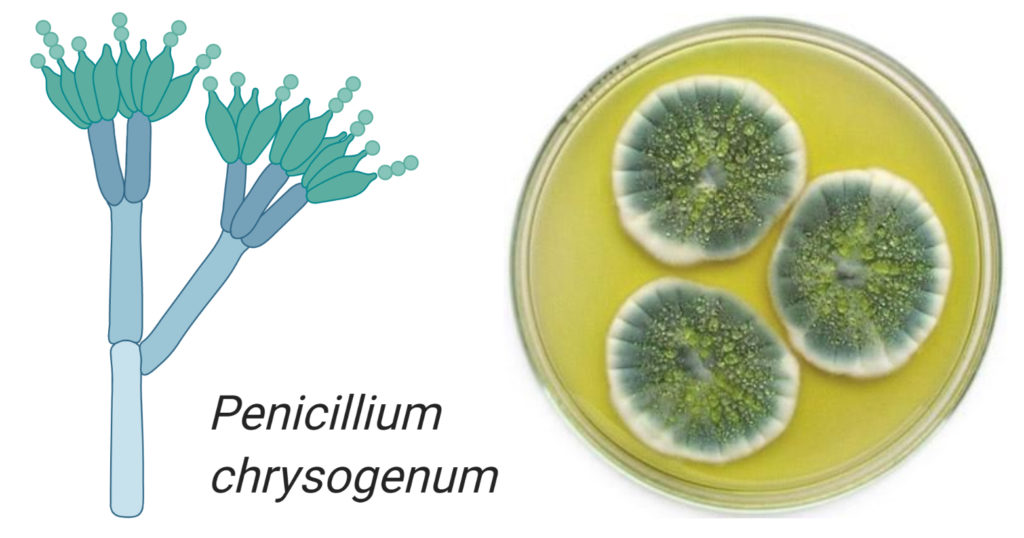Penicillium chrysogenum
Definition
Also known as Penicillium notatum
A fungus used for isolation of penicillin antibiotics (for gram-positive bacteria)
Also used for the production of other β-lactam antibiotics
May cause infections in immune-compromised persons
Habitat
Found indoors in areas that are humid, damp
found in temperate and subtropical areas
found in moist soil and degraded forest vegetation
It is saprophytic and can grow in dead decayed matter
Also grows in stored food and damp building material
Found in fruits causing decay
Morphology
Filamentous hyphae with conidia (asexual spores of the fungi).
Hyphae are colorless, slender, tubular, branched and septate.
The hyphae are formed from several threads of mycelium which form a network by intertwining
It reproduces by forming dry chains of spores known as conidia,
Fron the hyphal network, the conidiophores originate as long thick tubes with a swelling at the top, known as vesicles.
The vesicles produce the primary sterigmata from where the secondary sterigmata originate.
The secondary sterigmata form the conidial spores.
The conidia are long, cottony, or fluffy in texture.
Cultural characteristics
Penicillium chrysogenum colonies appear blue-green in color with a yellowish pigment.
Alexander Fleming described it as white fluffy mass” that later turns green then black.
Life Cycle of Penicillium chrysogenum
Penicillium chrysogenum reproduces asexually by producing asexual spores known as conidia.
The conidial spores are released by wind or water or animals.
They then land on a platform with the right growth and nutrient conditions, they start to germinate.
During germination, they form mycelial threads known as hyphae.
From the hyphae, conidiophore tubes are formed with a bulged vesicle at the top end.
From the vesicles, primary sterigmata originate also known as phialides.
The phialides form the conidial spores.
Pathogenesis of Penicilliun chrysogenum
It causes an opportunistic infection in people with severely suppressed immune systems such as HIV/AIDS patients.
Has pathogenicity
Symptoms :-
Pulmonary infection i.e pneumonia, localized granulomas, fungus balls, and systemic infection.
Systemic endophthalmitis.
Inducing allergen and asthma
Treatment
Surgical removal of the foci of the infection
Use of oral antifungals such as amphotericin B and itraconazole.
For systemic endophthalmitis, use of topical amphotericin B or itraconazole
Industrial Applications of Penicillium chrysogenum
Antibiotic production.
The fungus produces a hydrophobic ß-lactam compound known as penicillin.
Penicillin, an antibiotic for gram-positive bacterial infections such as pneumonia, gonorrhea, wounds, staphylococcal infections, bacterial fevers.
Penicillin structural variations classify it into two types, Penicillin G and penicillin V.
Prevention and Control
Using water to spray off areas where the fungus is growing, to reduce spore spread into the air.
Use bleaches and warm water to clean the walls.
* * * * * * * *



